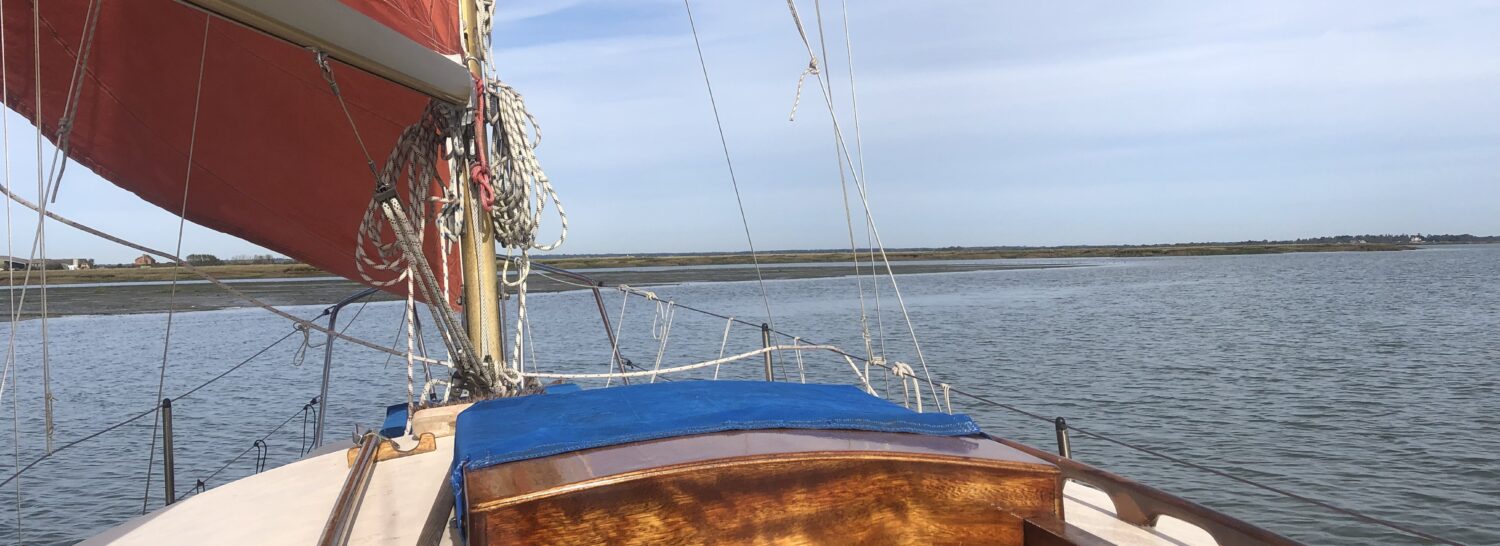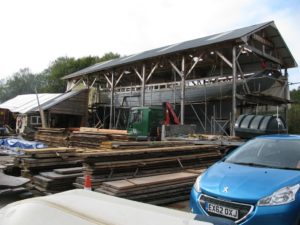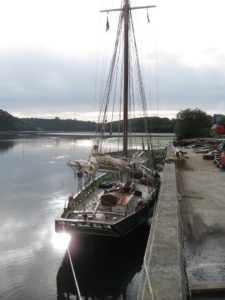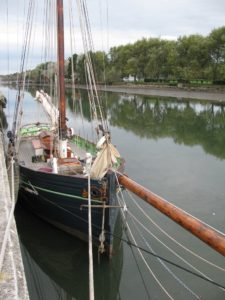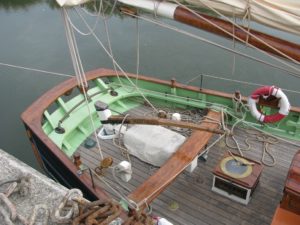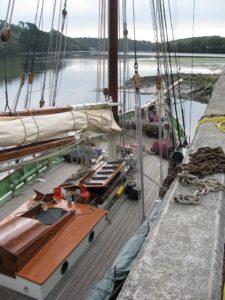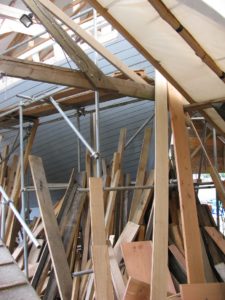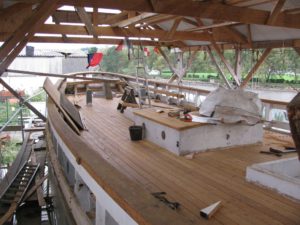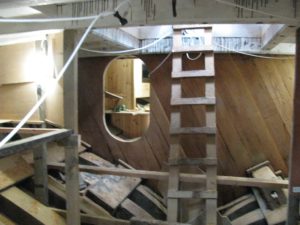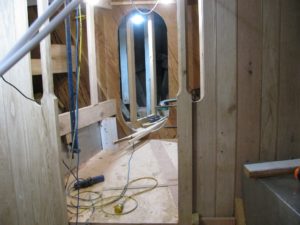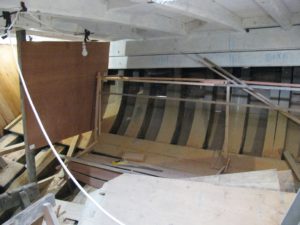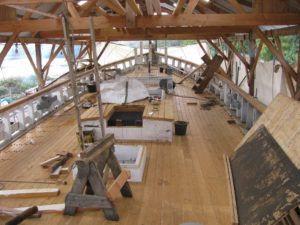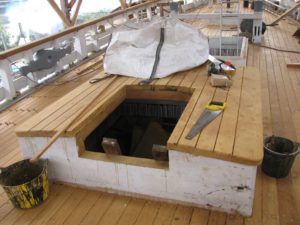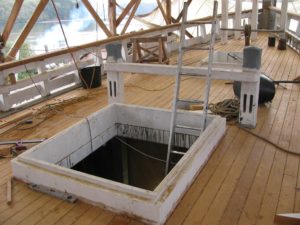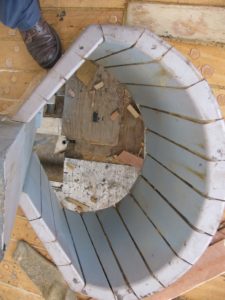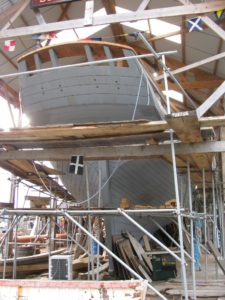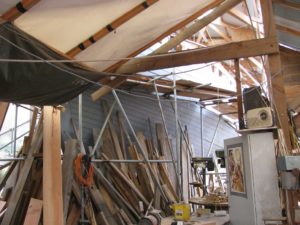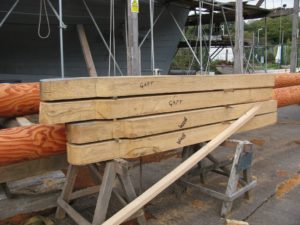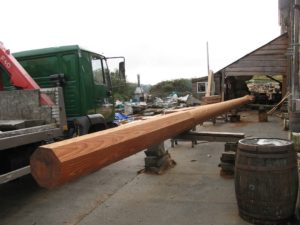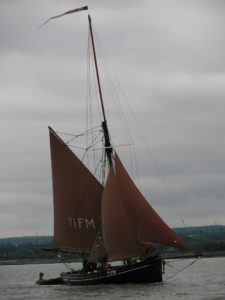While my wife and I were down in Cornwall on holiday – a NO BOATS holiday – I just happened to fall through the gates of the Rhoda Mary Shipyard down stream in Truro.
Now, the Rhoda Mary is a vessel I was quite intimate with as a youngster: with my older sibling, I would play around in her hull … probably without ‘mothers’ knowledge … the vessel had been hulked on the Hoo mud flats on the River Medway some years before.
My father aboard the Rhoda Mary in 1951. (Pic – Ardley family archive)
One of the ship’s anchors was removed and was used for one of the spritsail barge May Flower’s moorings (my chidlhood home). The anchor is now ‘lost’ for it is out on the mud flats off Callows Wharf up the top end of Milfordhope Creek. It’ll be sitting deep below lots of cord grass now…
My father also had some timber out of the old ship for use on May Flower!
The Rhoda Mary Trust was set up some years ago with the intention of providing a sail training vessel for Cornwall … plan were made to dig out the remains of the vessel on Hoo mud flats and rebuild her. The Rhoda Mary is the last of the ‘Cornish’ fruit schooners – fast vessels that brought fresh (citrus) fruit to England. To my mind she should be left in peace … a new vessel is the real answer: it is the rig and how it is used in the manner of her historical context which can be preserved.
The yard is the planned place … will it happen. Who really knows. Money will sit at the core.
Anyway, my good wife had a book to hand, so all was well!
A general view of the shipyard with a new vessel under construction.
Alongside the quay, where one day the current build project will soon be floating, rested an earlier vessel from the master builder Like Powell – the lynch-pin of this enterprise. The vessel, a small pilot cutter, Agnes, is something that is fulfilling to look at. She just hums with power and purpose – she twinkled in the light of an appearing sun…
The Agnes…
I took various shots to fulfill my desire to record: my chances of seeing her again are slight!
View from the bow.
Her ‘stern sheets’…
Deck view…
Now, my visit was to see the new vessel under construction up on the yards large open space – much filled with seasoning timber. The vessel is a faithful copy of a vessel built in 1852 – the Vincent. The new vessel has been named as the Pellew after a famous frigate captain, Edward Pellew who was a resident of Flushing (Cornwall).
Bottom of access and wood stack around the Pellew’s bow.
Mounting a set of stairs after being unable to find anyone ‘below’ I stepped upon the decks of this fine new build. Ones breath is taken away by the sheer size (not as big as a Thames barge…) and for me, the beauty of the workmanship going on. It hits you full on.
A look aft before stepping aboard…
A look forward too…
A radio was playing some kind of ‘modern’ music – a phenomenal ‘ghetto blaster’ – I called several times. No response. I could hear work going on below in at least two places. After a final call – I knocked. Ah, simple. One bit of noise stopped and a face appeared. This turned out to be shipwright Ned.
Explaining my desire to look over this fine new build, Ned, said, ‘…use that ladder … be careful and enjoy.’ at which he left me to my own devices. There follows a raft of views from below…
In main cabin looking aft towards door to ‘cuddy’…
In the aft cabin (cuddy?) I came upon a worker hard at it within the port bunk cubicle … her face appeared full of surprise … then got straight back to work!
Looking through forward cabin area into fo’c’sle
Intermediate space between fore and main areas with mast step.
Main cabin with some battens setting out ‘furniture’…
At this point I returned to the deck and took a closer look… The finish to bulwark capping, hatches and other areas essentially completed was seen to be superb. This is clearly not just a re-creation, but a work of art.
General view looking aft.
General view looking forward.
One of the cabin tops nearing completion awaiting its ‘furniture’…
This hatchway seemed to hint at the ability to load stuff through … I wasn’t able to ask about this! It clearly looks as if a ‘lid’ is to be fitted.
A less ‘yachty’ hatchway…
The rudder trunk…
I had to drag myself back to ground level, so mesmerised was I by what was being seen. I had a wander around the hull past the work bench areas with their ready to hand stacks of =off-cuts ready for that little job as things progress to a finishing stage.
The aft end of the Pellew.
Work bench area … not sure what the ladies on the team think about the calendar!
Mast and another spar in final shaping.
Rough-cut pieces ready for final shaping to make up gaff and boom jaws.
Further view of the mast. It is of massive section.
Reluctantly I made my way to the car and my waiting wife. She was fine: she’d brought a book along, knowing what I intended! As I drove out of the yard gates, I cast a wistful look out of the side window, picturing the Pellew afloat, mast at a cocky angle, sails bent on ready for her first passage…
Before my visit I had become aware that Luke Powell and his partner Joanna had purchased a ‘famous’ east coast boat, the Whitstable smack Stormy Petrel which had for many years – around sixty – been owned by Dick Norris. Dick had, as we all will, got old and had reluctantly sold his beloved vessel. Stormy Petrel was once owned by the renowned bargeman and sailor, Bob Roberts. Bob had her during the latter part of the 1940s selling her in the 1950s. Stormy Petrel transported family and belongings to Pin Mill when Bob decamped ‘north’.
So, this famed little ship will ‘go west’, perhaps never to return.
Some years ago I met the ‘Petrel‘ tacking in a stiff breeze up Pinup Reach just below Gillingham where Dick Norris had kept her for probably all his ownership. Dick knew my parents well from the 1950s onward, meeting out on the water – the May Flower and Stormy Petrel – both things of a past age.
Stormy Petrel reefed down and going well…
Stormy Petrel tacking … note the long foot to the foresail.
The Stormy Petrel is currently at Faversham at Chamber’s Wharf near Alan Staley’s yard.
In brief, Luke Powell has had an interesting life. Born in Suffolk he ended up in the Greek Isles before eventually pitching up in Faversham (Kent), worked on Thames spritsail barges before he trained as a shipwright.
Look after this piece of Kentish history in Cornwall, Luke: we’ll all miss her up here…
For more info see: http://thefalmouthpilotcutter.co.uk/the-rhoda-mary-ship-yard/
and, http://www.rhoda-mary.co.uk/
